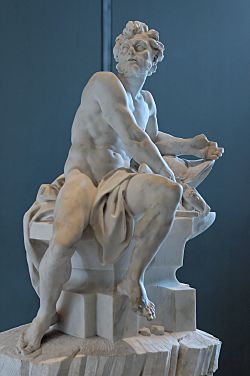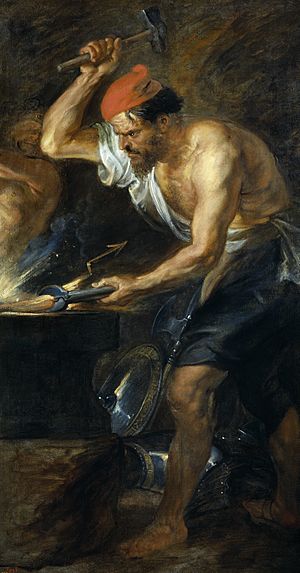Hephaestus facts for kids
Quick facts for kids Hephaestus |
|
|---|---|
| God of fire, metalworking, stone masonry, forges, the art of sculpture, technology, and blacksmiths | |
| Member of the Twelve Olympians | |

Hephaestus at the Forge by Guillaume Coustou the Younger (Louvre)
|
|
| Abode | Mount Olympus |
| Symbol | hammer, anvil, tongs |
| Personal information | |
| Consort | Aphrodite (divorced) Aglaea |
| Children | Thalia, Erichthonius, Eucleia, Eupheme, Philophrosyne, Cabeiri and Euthenia |
| Parents | Zeus and Hera, or Hera alone |
| Siblings | Aeacus, Angelos, Aphrodite, Apollo, Ares, Artemis, Athena, Dionysus, Eileithyia, Enyo, Eris, Ersa, Hebe, Helen of Troy, Heracles, Hermes, Minos, Pandia, Persephone, Perseus, Rhadamanthus, the Graces, the Horae, the Litae, the Muses, the Moirai |
| Equivalents | |
| Roman equivalent | Vulcan |
| Canaanite equivalent | Kothar-wa-Khasis |
| Egyptian equivalent | Ptah |
Hephaestus was a very important Greek god. He was known as the god of fire and volcanoes. Hephaestus was also the amazing blacksmith for all the gods on Mount Olympus. He made all their special weapons and tools. His main symbols are a smith's hammer, an anvil, and a pair of tongs. People who worked with metal, like blacksmiths, looked up to him. In ancient Greece, small statues of Hephaestus were often placed near the fireplace in homes.
Hephaestus's parents were Hera and Zeus, the king and queen of the gods. Sometimes, it is said that Hera created him all by herself. His grandparents were Kronos and Rhea. The main place where Hephaestus was worshipped was on the island of Lemnos. In Roman stories, his equivalent god is called Vulcan.
Contents
His Birth and Early Life
When Hephaestus was born, he looked different from the other gods. He was weak and had a broken foot. His mother, Hera, was not happy with how he looked. Because of this, she threw him off Mount Olympus, the home of the gods.
Hephaestus fell for a whole day and night. He finally landed in the sea. Luckily, sea creatures found him and saved him. They took him to an island called Lemnos. There, Hephaestus built his workshop under a volcano. He used precious metals, pearls, and coral to make amazing jewelry. He even built little robots made of gold to help him move around. Hephaestus also worked with the Cyclopes, who were giant one-eyed creatures. To show off his skills, he made beautiful golden thrones for all the gods and goddesses.
Return to Olympus
Hera soon realized she had made a mistake by throwing Hephaestus away. She asked Zeus to bring Hephaestus back to Mount Olympus. Hephaestus politely said no, as he was happy where he was. But he decided to make a special golden throne for Hera as a "thank you" gift.
The moment Hera sat on the throne, golden ropes flew out and tied her up! She was stuck in the chair. No one could free her, no matter how hard they tried. Hephaestus's design was too clever. Zeus then sent Dionysus, the god of wine, to convince Hephaestus to return. Hephaestus finally agreed to free Hera. However, he still found it hard to forgive her completely.
Hera felt very guilty. She gave Hephaestus many supplies, materials, tools, and helpers for his workshop. Hephaestus then made the best weapons, jewelry, and armor. Some of his most famous creations include:
- The silver bows and arrows for Artemis and Apollo.
- Apollo’s golden chariot.
- The mighty shield of Achilles.
- Athena's spear.
- Hercules's breastplate.
- Zeus's scepter and the armor for the Olympian armies.
Hephaestus also built all the palaces for the gods and goddesses. He even made their unbreakable locks. Besides these, Hephaestus is also known for inventing the three-legged stool and the world’s first robots. He had life-sized golden maids who helped him around his home.
Marriage to Aphrodite
Hephaestus married Aphrodite, the goddess of love and beauty. When Aphrodite was born, Zeus worried that the other gods would fight over who would marry her. So, Zeus decided that Aphrodite should marry Hephaestus.
Hephaestus gave Aphrodite his best creations. He even gave her a magic girdle that made her even more charming. However, Aphrodite did not truly love him. She was married against her will and did not like Hephaestus's appearance. She often spent her time with Ares, the god of war.
Hephaestus was generally liked by the other Olympians. He usually stayed out of their arguments and preferred to be alone in his workshop. The ancient Greeks also admired Hephaestus because he showed that hard work and labor were noble qualities.
Symbolism
Hephaestus was often shown as a strong man with a beard. He was usually seen with his hammer or another crafting tool. He also wore an oval cap and a chiton, which was a type of tunic. He was often shown with curved feet. This was either how he was born or a result of his fall from Mount Olympus.
Namesakes
- A minor planet discovered in 1978 was named 2212 Hephaistos in his honor.
- The sooty grunter (Hephaestus fuliginosus), a dark freshwater fish from Australia, is also named after Hephaestus.
Related pages
Images for kids
-
The Doric Temple of Hephaestus in the Agora of Athens.
See also
 In Spanish: Hefesto para niños
In Spanish: Hefesto para niños




